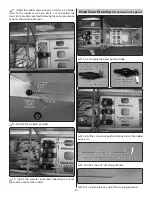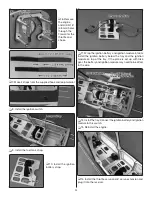
34
●
Keep these items away from the prop: loose clothing, shirt
sleeves, ties, scarfs, long hair or loose objects such as
pencils or screwdrivers that may fall out of shirt or jacket
pockets into the prop.
●
Stop the engine before making any engine adjustments.
●
The engine and muffl er get hot! Do not touch them during
or right after operation. Make sure fuel lines are in good
condition so fuel will not leak onto a hot engine, causing
a fi re.
●
To stop a gasoline powered engine an on/off switch must
be connected to the engine ignition. Do not throw anything
into the propeller of a running engine.
ELECTRIC MOTOR SAFETY PRECAUTIONS
●
Read and follow the battery and ESC instructions carefully
for correct use and operation.
●
The motor gets HOT! Do not touch it during or right after
operation.
●
When working on your plane, remove the propeller if the
motor batteries will be connected.
●
Always remove the motor batteries when charging.
●
Follow the charging instructions included with your charger
for charging LiPo batteries. LiPo batteries can cause
serious damage if misused.
●
Once the motor batteries are connected, the electric motor
can start at any time. Make sure the fail safe is set on your
radio to prevent the motor from starting if the signal is lost.
●
ALWAYS
unplug the motor batteries fi rst.
●
NEVER
switch off the transmitter with the motor batteries
plugged in.
●
WARNING:
Read the entire instruction sheet included
with your motor batteries. Failure to follow the instructions
could cause permanent damage to the battery and its
surroundings and cause bodily harm!
●
ONLY
use a LiPo approved charger.
●
NEVER
use a NiCd/NiMH peak charger to charge a LiPo
battery.
●
NEVER
charge in excess of 4.20V per cell.
●
ONLY
charge through the “charge” lead.
●
NEVER
charge through the “discharge” lead.
●
NEVER
charge at currents greater than 1C unless the
battery is rated for a higher charge rate.
●
ALWAYS
set the charger’s output volts to match the
battery volts.
●
ALWAYS
charge a LiPo battery in a fi reproof location.
●
NEVER
trickle charge a LiPo battery.
●
NEVER
allow the battery temperature to exceed 150° F
(65° C).
●
NEVER
disassemble or modify the pack wiring in any way
or puncture the cells.
●
NEVER
discharge below 2.7V per cell.
●
NEVER
place the battery or charger on combustible
materials or leave it unattended during charge or discharge.
●
ALWAYS
KEEP OUT OF THE REACH OF CHILDREN.
●
NEVER
charge the battery in the plane.
●
ALWAYS
remove the battery from the plane after a crash.
Set it aside in a safe location for at least 20 minutes. If the
battery is damaged in the crash it could catch fi re.
●
If the battery starts to swell, quickly move the battery to
a safe location, preferably outside. Place it in a bucket,
covering the battery with sand. Never use water to try
and put out a LiPo fi re.
AMA SAFETY CODE (excerpts)
Read and abide by the following excerpts from the Academy
of Model Aeronautics Safety Code. For the complete Safety
Code refer to Model Aviation magazine, the AMA web site
or the Code that came with your AMA license.
General
1) I will not fl y my model aircraft in sanctioned events, air
shows, or model fl ying demonstrations until it has been
proven to be airworthy by having been previously, successfully
fl ight tested.
2) I will not fl y my model aircraft higher than approximately
400 feet within 3 miles of an airport without notifying the
airport operator. I will give right-of-way and avoid fl ying in the
proximity of full-scale aircraft. Where necessary, an observer
shall be utilized to supervise fl ying to avoid having models
fl y in the proximity of full-scale aircraft.
3) Where established, I will abide by the safety rules for the
fl ying site I use, and I will not willfully and deliberately fl y my
models in a careless, reckless and/or dangerous manner.
5) I will not fl y my model unless it is identifi ed with my name
and address or AMA number, on or in the model. Note: This
does not apply to models while being fl own indoors.
7) I will not operate models with pyrotechnics (any device
that explodes, burns, or propels a projectile of any kind).
Radio Control
1) I will have completed a successful radio equipment ground
check before the fi rst fl ight of a new or repaired model.
2) I will not fl y my model aircraft in the presence of spectators
until I become a qualified flier, unless assisted by an
experienced helper.
3) At all fl ying sites a straight or curved line(s) must be
established in front of which all fl ying takes place with the
other side for spectators. Only personnel involved with fl ying
the aircraft are allowed at or in the front of the fl ight line.
Intentional fl ying behind the fl ight line is prohibited.
4) I will operate my model using only radio control frequencies
currently allowed by the Federal Communications Commission.



































